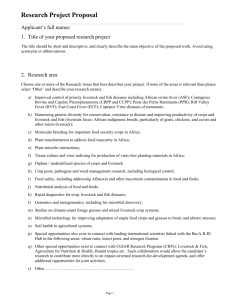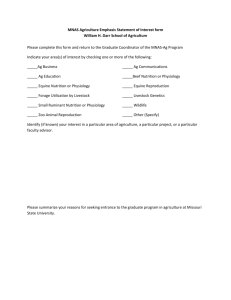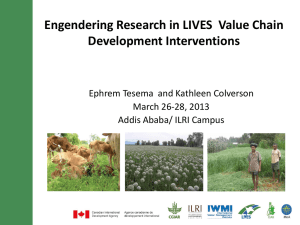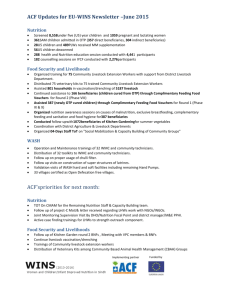Group 3(B)-WAwriteshop
advertisement
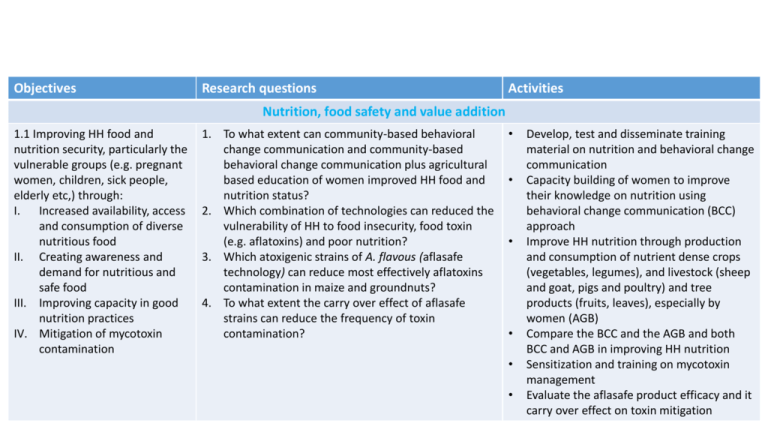
Objectives Research questions Activities Nutrition, food safety and value addition 1.1 Improving HH food and nutrition security, particularly the vulnerable groups (e.g. pregnant women, children, sick people, elderly etc,) through: I. Increased availability, access and consumption of diverse nutritious food II. Creating awareness and demand for nutritious and safe food III. Improving capacity in good nutrition practices IV. Mitigation of mycotoxin contamination 1. To what extent can community-based behavioral change communication and community-based behavioral change communication plus agricultural based education of women improved HH food and nutrition status? 2. Which combination of technologies can reduced the vulnerability of HH to food insecurity, food toxin (e.g. aflatoxins) and poor nutrition? 3. Which atoxigenic strains of A. flavous (aflasafe technology) can reduce most effectively aflatoxins contamination in maize and groundnuts? 4. To what extent the carry over effect of aflasafe strains can reduce the frequency of toxin contamination? • • • • • • Develop, test and disseminate training material on nutrition and behavioral change communication Capacity building of women to improve their knowledge on nutrition using behavioral change communication (BCC) approach Improve HH nutrition through production and consumption of nutrient dense crops (vegetables, legumes), and livestock (sheep and goat, pigs and poultry) and tree products (fruits, leaves), especially by women (AGB) Compare the BCC and the AGB and both BCC and AGB in improving HH nutrition Sensitization and training on mycotoxin management Evaluate the aflasafe product efficacy and it carry over effect on toxin mitigation Objectives Research questions Activities Nutrition, food safety and value addition Reducing post-harvest loss and improving shelf life through better pre-harvest, harvest and post-harvest practices 1. Which combination of technology packages can reduce pre-harvest, harvest and post-harvest losses and improve product quality and self life? Improve the market value of agricultural produce through value addition thereby increasing household income and nutritional value 1. What are the promising value chain of agricultural products that can be reinforced to increase small household income and nutritional value? 2. What options/technologies or combination of technologies can add value to crop and livestock products to increase their marketability? • • • • • Identify and document potential technologies to reduce pre-harvest, harvest and post-harvest losses and contaminations Evaluate the cost effectiveness of the existing technology packages for potential adaptation or recommendation Conduct a SWOT analysis to identify market niches/opportunities of agricultural products Identify, evaluate and adapt options/technologies or combination of technologies to add value to crop and livestock products Promote institutional arrangement to facilitate linkages between smallholder farmers and private sector Objectives Research questions Activities Resilient production systems Develop and enhance integrated crop-livestock systems to improve productivity, profitability and reduce risks of small holder farmers without degrading the natural resource base 1. What options or combination of options can we develop/promote to improve the resilience of farming systems? 2. What options or combination of options of improved crops (cereals, legumes, vegetables), and trees/shrub, livestock breeds and agronomic/husbandry practices would increase productivity and profitability of smallholder farming as well as food security and reduce risks? 3. Which combination of soil, land and water management practices would increase food and feed yields without degrading the natural resources 4. Which integrated crops and livestock management practices will conserve the natural resource base (soil, land, water and plant biodiversity) and improve productivity • • • Evaluate and adapt improved crops, trees/shrubs, livestock management practices to intensify/diversify the farming systems without degrading the natural resources Evaluate and adapt integrated crops, trees/shrubs and livestock management practices to conserve the natural resource base (soil, land, water and plant biodiversity) and improve productivity and profitability Establish and characterize watershed areas to evaluate and adapt integrated soil water and land management practices to increase productivity and profitability, and maintain the natural resource base Objectives Research questions Outputs Activities Markets, institutions and gender 1. Enhancing institutional options to improve; i. market access (both agricultural inputs and outputs), ii. access to sustainable intensification technologies 1. What are the main impediments (institutional and socioeconomics) constraints to markets access (inputs and outputs) and to adoption of SI technologies? 2. What institutional arrangements can be promoted/developed to increase access markets (input sand outputs) and SI technologies? • To empower the vulnerable groups (women and youth) for equitable access to and control of production assets (land, labour, credits etc) 1. What are the gender differentiations on crops and livestock production, processing and marketing? 2. To what extent can labor and time inputs of vulnerable groups into pre-harvest, harvest and post harvest activities be reduced through the use of small scale machinery • • • • Assess the market efficiency of agricultural products (inputs and outputs) Identify, adapt and promote new institutional arrangement to increase the marketability of crops and livestock products and link farmer to inputs and outputs marckets Assess the level of inclusiveness of women and youth along the crop and livestock value chains Evaluate the labor productivity (labor use efficiency) through the use of pre and post harvest small scale machinery Promote and empower vulnerable groups in using small scale machinery Objectives Research questions Activities Development To achieve impact at scale of project interventions through engagement with different stakeholders via: I. Inclusive R4D platforms II. Strategic communication for effective dissemination of project outputs III. Building/strengthening synergies with leverage opportunities with development actors (NGOs, private and public sectors) IV. Effectively deliver information and knowledge and build capacity to scale out and up proven technologies 1. Who are the key actors at the community and district levels that are required to be at the R4D platforms? 2. What are the best and efficient delivery channels/networks for information and knowledge/products exchange to farmers and other partners including the private and public sectors? 3. What is the efficient linkage and partnership with the national authorities that will support and facilitate the process of registration and licensing for a dissemination at scale of mature products (e.g. aflasafe)? 4. Research on outscaling? • • • • Identify and categorize relevant stakeholders that can be engaged in processes to address specific constraints that farmers face. Evaluate, validate and promote effective delivery channels/networks for a smooth exchange of information and knowledge/products to farmers and other partners including private and public sectors Registration and licensing of mature products (e.g. aflasafe etc…) Building effective and appropriate partnership to enhance a dissemination at scale of mature products (e.g. aflasafe etc…)
